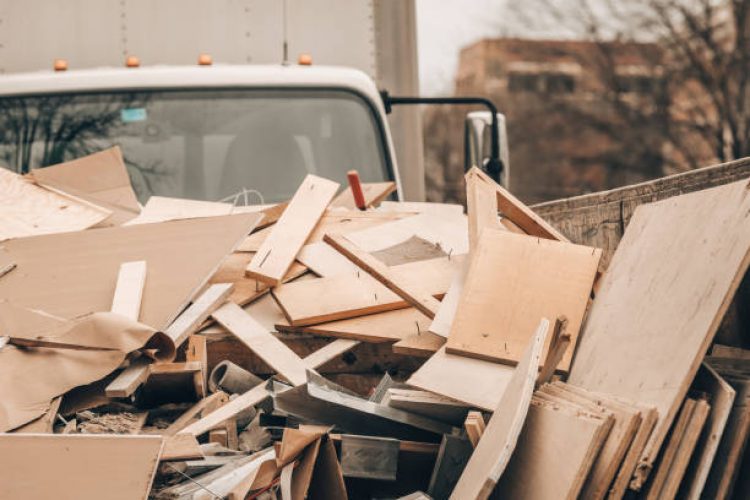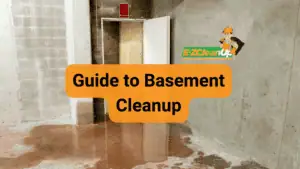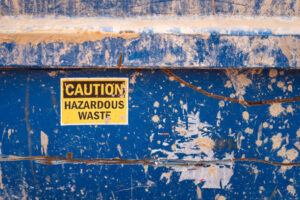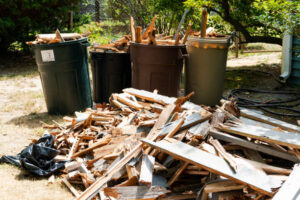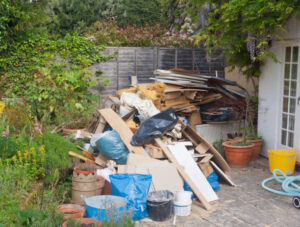Large-scale renovations generate significant amounts of debris—from old fixtures and damaged materials to packaging waste and construction leftovers. Construction and renovation projects contribute significantly to the demand for junk removal services, with around 20% of jobs coming from these sectors. Without a strategic waste management plan, your renovation project can quickly become overwhelmed with clutter, leading to safety hazards, project delays, and inflated costs.
According to EPA, 600 million tons of construction and demolition (C&D) debris in the United States were produced in 2018, more than twice the total municipal solid waste in one year. This staggering statistic underscores the critical importance of effective junk removal strategies during renovation projects.
This comprehensive guide will walk you through proven strategies to manage junk removal efficiently during your large-scale renovation, helping you save time, reduce costs, and minimize environmental impact.
Understanding the True Cost of Construction Waste
Many project managers underestimate the real financial impact of construction waste. The true cost of waste in the construction industry is generally quoted to be 10-20 times greater than the disposal cost, and the true cost of waste for a construction project can actually be 2% up to 10% of the total project’s costs.
A survey by the National Association of Home Builders (NAHB) found that furniture accounts for 18% of the total waste generated during home renovations. Understanding these costs upfront allows you to budget appropriately and identify opportunities for savings through better waste management practices.
Create a Waste Management Plan Before You Begin
Waste management and reduction initiatives will be much more effective when they’re mapped out from the very beginning of the project—i.e., the planning and design stage. Before demolition begins, develop a comprehensive Site Waste Management Plan (SWMP) that outlines:
- Waste estimation: Calculate expected debris volumes by material type
- Sorting strategy: Determine which materials will be recycled, reused, or disposed
- Container placement: Plan strategic locations for dumpsters and recycling bins
- Disposal partners: Research and hire professional junk removal services in advance
- Timeline coordination: Schedule waste pickups to avoid site overflow
The best way to reduce the amount of waste generated on site is to design it out at the beginning. This means making design decisions that prevent waste from being produced in the first place, increase the amount of recycled content used within the build, and increase the future recyclability of the materials.
Implement Effective Waste Segregation Systems
One of the most crucial aspects of managing junk removal during renovations is proper waste segregation. Establish a system for separating recyclable and reusable materials. You could, for instance, set up designated bins for different types of waste, such as metal, wood, and plastic. Doing so streamlines the recycling process and makes it easy for people to do their part in minimizing construction waste.
Three Segregation Methods:
Site-Separated Recycling: Separating construction waste on the job site gives immediate feedback to everyone on the job and can help to ensure that the project’s recycling goals are met. Site separation also promotes a responsible atmosphere on the job site and is the best method for diversion goals.
Commingled Recycling: This single-container approach is best for space-constrained sites where the hauler sorts materials off-site.
Hybrid Recycling: Combining both methods—for example, separate containers for wood and concrete, with one container for mixed recyclables—offers flexibility based on your project needs.
Partner with Professional Junk Removal Services
Revenue in the U.S. residential junk removal segment is projected to reach $6.1 billion in 2024. This indicates a strong demand for junk removal services among homeowners, driven by factors such as decluttering, home renovations, and moving.
When selecting a junk removal partner for your large-scale renovation, look for:
- Licensed and insured operators: Ensure compliance with local regulations
- Recycling commitment: According to the EPA, only about 35% of construction and demolition waste is recycled or recovered. Junk removal companies play a vital role in diverting waste from landfills by promoting recycling, donating reusable items, and disposing of hazardous materials responsibly.
- Flexible scheduling: Companies that can adapt to your project timeline
- Transparent pricing: Clear estimates with no hidden fees
- Proper equipment: Adequate truck capacity and specialized handling capabilities
Maximize Recycling and Donation Opportunities
Asphalt, concrete, and rubble are often recycled into aggregate or new asphalt and concrete products. Wood can be recycled into engineered-wood products like furniture, as well as mulch, compost, and other products. Metals—including steel, copper, and brass—are also valuable commodities to recycle. Additionally, although cardboard packaging from home-building sites is not classified as a C&D material, it does make its way into the mixed C&D stream, and many markets exist for recycling this material.
Consider salvaging materials for reuse or donation:
- Cabinets, doors, and windows in good condition
- Functioning appliances
- Lighting fixtures
- Hardwood flooring
- Architectural elements with character
Not only does this reduce landfill waste, but it can also provide tax deductions and benefit local communities.
Handle Hazardous Materials Properly
After renovations or large cleanouts, property managers often deal with hazardous waste, including solvents, batteries, and paint. Different states have specific regulations regarding the handling of such materials. Junk removal companies specializing in hazardous waste ensure compliance and proper disposal, helping landlords avoid legal risks.
Common hazardous materials in renovations include:
- Lead paint chips
- Asbestos-containing materials
- Solvents and chemicals
- Fluorescent bulbs
- Electronic waste (e-waste)
Never dispose of these materials in standard dumpsters. Always work with certified hazardous waste disposal specialists.
Optimize Container Management
Concrete constitutes around 70% of C&D waste, and as it’s heavy, the disposal costs over a remodeling or refurbishing contract can be significant. Fortunately, concrete doesn’t have to turn to ‘waste.’ If it is not contaminated with trash, wood or reinforcing materials, it can be recycled on site with portable crushers.
Strategic dumpster management includes:
- Right-sizing containers: Match bin capacity to waste volume
- Strategic placement: Position containers for easy access but minimal disruption
- Scheduled pickups: Project managers sometimes have to make emergency call-outs for their dumpsters to be emptied to enable their sites to function safely, however, these are generally much more expensive. Proactive management of your waste volumes and haulers during the project will enable collections to be optimized, generating considerable savings.
- Multiple containers: Use separate bins for different material types
Train Your Team on Waste Management Protocols
Train workers on waste reduction techniques. See to it that the team members carrying out your waste management processes are well aware of best practices and have the resources they need to efficiently sort, recycle, and dispose of materials.
Effective training should cover:
- Proper sorting techniques
- Identifying recyclable materials
- Hazardous waste recognition
- Container usage protocols
- Safety procedures
By understanding the impact of their actions, workers can actively contribute to minimizing waste. On top of training, fostering a culture of sustainability within the organization is crucial. Encouraging open communication, recognizing and rewarding sustainable practices, and involving workers in decision-making processes can create a sense of ownership and commitment to waste reduction.
Monitor and Measure Your Waste Management Progress
Construction professionals should establish methods to track and assess their waste management practices. Regular site inspections can identify areas where most of the waste is accumulating and look for potential areas for improvement. Implementing waste tracking systems, such as digital logs or mobile apps, allows for real-time data collection and analysis. This data can help crews identify trends, measure progress, and make informed decisions.
Track key metrics including:
- Total waste volume by material type
- Recycling and diversion rates
- Disposal costs
- Container utilization efficiency
- Incidents of improper disposal
Use this data to refine your waste management strategy for current and future projects.
Leverage Technology for Better Waste Management
Digital tools can streamline junk removal management during renovations. Consider implementing:
- Project management software: Track waste-related activities and costs
- Digital scheduling platforms: Coordinate pickups and deliveries
- Waste tracking apps: Monitor disposal volumes and recycling rates
- Inventory management systems: Reduce material over-ordering
Technology is transforming junk removal for property managers, making it easier to manage multiple sites and services. Junk removal apps and online booking systems streamline scheduling and tracking, while AI-driven sorting improves recycling efficiency and reduces landfill waste.
Timing Your Junk Removal for Maximum Efficiency
Coordinate junk removal with your renovation phases:
- Pre-demolition: Remove salvageable items before destruction
- During demolition: Schedule frequent pickups to maintain site safety
- Mid-renovation: Regular removal of packaging and construction waste
- Post-renovation: Final cleanout and disposal of remaining debris
The average junk removal job takes approximately 1-2 hours to complete. Plan accordingly to minimize disruption to your renovation schedule.
Cost Considerations and Budgeting
On average, residences spend $210 for junk removal services, while businesses spend an average of $500. However, large-scale renovations typically require multiple pickups and specialized handling, so budget accordingly.
Factors affecting junk removal costs include:
- Volume and weight of debris
- Material types (standard vs. hazardous)
- Location and accessibility
- Frequency of pickups
- Recycling and sorting requirements
Get detailed quotes from multiple providers and factor waste management into your overall renovation budget from the start.
Environmental Benefits of Proper Junk Removal Management
Beyond regulatory compliance, effective waste management during renovations offers significant environmental benefits. By maximizing recycling and reuse, you contribute to resource conservation and reduced landfill burden.
EPA promotes a Sustainable Materials Management (SMM) approach that identifies certain C&D materials as commodities that can be used in new building projects, thus avoiding the need to mine and process virgin materials.
Conclusion
Managing junk removal during a large-scale renovation requires careful planning, strategic partnerships, and consistent execution. By implementing a comprehensive waste management plan, segregating materials properly, partnering with professional junk removal services, and training your team, you can significantly reduce costs, improve safety, and minimize environmental impact.
Responsible management of waste is an essential aspect of sustainable building. In this context, managing waste means eliminating waste where possible; minimizing waste where feasible; and reusing materials which might otherwise become waste.
Start your next renovation project with a solid junk removal strategy, and you’ll see the benefits in your timeline, budget, and environmental footprint.
References
- U.S. EPA – Sustainable Management of Construction and Demolition Materials
- National Association of Home Builders – Construction Waste Management
- Junk Removal Industry Statistics 2024 – World Metrics
- Construction Waste Management Best Practices – National Waste
- Construction Waste Management Guide – Whole Building Design Guide

